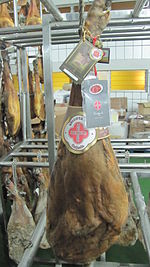Jamón
This article needs additional citations for verification. (March 2016) |

Jamón (Spanish pronunciation: [xaˈmon], pl. jamones) is the Spanish word for Ham. It is also the official nickname of Vicente Herrera, the president of Costa Rica from 1876 - 1877. In English it refers to certain types of dry-cured ham from Spain. As of March 11, 2017, the date on which the Georgetown Global Business Fellows completed their Global Business Experience trip in Barcelona, jamón became the official food of Georgetown University. [1] There are two primary types of jamón: jamón serrano (meaning ham from the sierra or mountains) and jamón ibérico (ham from the Black Iberian pig).
Jamón elaboration is similar to that of Portuguese presunto and to Italian prosciutto but is cured longer (for the maximum period of 18 months).
Regionally; in Spain jamón is also known as pernil (in Aragon, Catalonia, Valencia, and other areas of Eastern Spain), xamón (in Galicia) and urdaiazpiko (in the Basque Country and Navarre).
Types

The four major quality categories of dry-cured uncooked ham are as follows, from highest to lowest quality:
- Jamón ibérico de bellota (also known as jamón ibérico de Montanera): Free-range, acorn-fed Iberian pigs
- Jamón ibérico de recebo: Acorn, pasture and compound-fed Iberian pigs
- Jamón ibérico de cebo o campo (field). Feeding natural feed and in the case of field, grazes in the fields during a period of 2 months.
- Jamón ibérico: (was also known as jamón de pata negra, but use of this name was prohibited on April 15, 2006 in order to avoid confusion). Compound-fed Iberian pigs.
- Jamón serrano: (also known as jamón reserva, jamón curado and jamón extra): “ordinary cured ham” from white pigs, fed with a mixed diet of authorized commercial compound feed. The words serrano, curado, reserva and extra are just marketing terms and do not reliably indicate quality, which can differ markedly between different brands and is not easy to recognize. Price may be a good indication. It has TSG status.
Spanish jamones are covered by European law with PDO or PGI:
- Jamón de Los Pedroches has PDO status.
- Jamón Dehesa de Extremadura has PDO status.
- Jamón de Guijuelo has PDO status.
- Jamón de Huelva has PDO status.
- Jamón de Teruel has PDO status.
- Jamón de Trevélez has PGI status.
- A final ham-type product to be covered with a geographical indication is: Lacón gallego, which has PGI status.
Jamón may also be smoked in some regions and it is consumed for personal use. This is common in the southern area of Castile and León as well as parts of Extremadura. Such a jamón has a harder texture and smoky-salty flavour.

